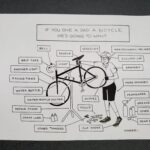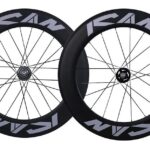Confidence is a deep, lasting, and resilient belief in your ability to ride your best and achieve your cycling goals. Confidence keeps you positive, motivated, intense, focused, and emotionally in control when you need it most, whether on a long and grueling climb or when you’re trying to reel in a breakaway with only a few miles left. You’re able to stay confident even when you’re not riding well and, for example, you’re dropped from the lead pack (it happens to the best cyclists). You’re not negative or uncertain in difficult races nor overconfident in easy races. It also encourages you to seek out pressure situations and to view hard conditions and tough opponents as challenges to pursue. Ultimately, confidence enables you to ride at your highest level consistently.
Five Keys to Prime Confidence
I have identified five keys to building confidence in your cycling that will create an upward spiral of belief and determination. Each key alone can enhance your confidence, but if you use all of them together, you’ll find your confidence growing stronger and more quickly. The ultimate goal of cycling confidence is to develop a strong and resilient belief in your riding ability so that you have the confidence to give your best effort, ride at your highest level, and believe you can achieve your goals in the most important races of your life.
Preparation breeds confidence. Preparation is the foundation of confidence. This preparation includes the physical, technical, tactical, equipment, and mental parts of cycling and means putting in the necessary time and effort into every aspect of your training. If you have developed these areas as fully as you can, you will have faith that, when you get to the stat line of a race, you will be able to use those capabilities gained from preparation to ride as well as you can in the race. The more of these areas you fully address in your preparation, the more confidence you will breed in yourself. My goal with the cyclists I work with is, when they arrive at every race, that they can say, “I’m as prepared as I can be to achieve my goals.”
Mental skills reinforce confidence. In all likelihood, you have a toolbox that includes wrenches, oil, spare parts, and much more. You have this toolbox to keep your bike in tip-top shape and to fix breakdowns when they occur. I encourage you to also create a mental “toolbox,” inside of which you put essential mental tools that you will need in training and races (fortunately, your mental toolbox doesn’t weigh anything, even when it’s filled with tools!). Just like having a spare tire if you get a flat during a ride, the tools in your mental toolbox are available when you have breakdowns in riding, for example, you get nervous before a race, begin to despair after being dropped on a climb, are really hurting late in a race. Tools that you can place in your mental toolbox can include inspirational thoughts and images to bolster your motivation, positive self-talk and body language to fortify your confidence, intensity control to combat confidence-depleting anxiety, keywords to maintain focus and avoid distractions, and emotional-control techniques to calm yourself under pressure.
Adversity ingrains confidence. Like most cyclists, you probably love to train in ideal conditions when you’re healthy, rested, and on your game. But how often do you race under ideal conditions? Probably not that often. More often than not, the worst conditions come out when you want them least, for example, rough roads, rain, cold, and a stiff headwind. But it isn’t the conditions that determine who succeeds and who fails because, for example, two riders can face the same conditions, but view and respond to them entirely differently. Rider A may see them as a threat that causes negativity and anxiety. Rider B sees those same conditions as a challenge and becomes motivated and excited. So who do you think is going to have a better race, all else being equal? The challenge is to maintain your confidence when you’re faced with the worst possible conditions.
To more deeply ingrain confidence, you should expose yourself to as much adversity as possible in training. Adversity can be environmental obstacles such as bad weather. Adversity can also involve riding with a group that is just a bit above your capabilities.
Training for adversity has several essential benefits. Adversity increases your belief that you can respond positively to the difficult conditions because you’ve shown yourself that you can in training. It shows you ways to adapt to the adversity so you can make those adjustments in races, for example, riding in a lower gear into a headwind or knowing what to wear during very cold weather. Training for adversity also familiarizes you with hard conditions, so when you get to a race with such demands, you’ll be confident enough to say, “No big deal, I’ve trained in these conditions before.” Plus, training for adversity just makes you feel tough!
Support bolsters confidence. It’s difficult to achieve success on your own. The best riders in the world have many people supporting them. There will be times when things are just not going well and it helps to have people, for example, family, friends, coaches, and teammates, to whom you can turn for support and encouragement. Though your confidence may wax and wane depending on how you’re feeling, the quality of your training, and your recent race results, you want people in your life who you can count on to give you a “booster shot” of confidence, for example, have a coach say, “I know you can do it” or a friend tell you, “Hang in there. Things will turn around.”
Success validates confidence. All of the previous steps in building confidence will go for naught if you don’t then ride well and achieve your goals. Success validates the confidence you have developed in your ability; it demonstrates that your belief in your ability is well-founded. Success further strengthens your confidence, making it more resilient in the face of adversity and poor performance. Success also rewards your efforts to build confidence, encouraging you to continue to work hard and develop your capabilities.
But when I talk about success, I don’t mean just race success, such as a podium finish, at least not right away. You can’t just go out and have a big success to give you confidence. Your initial goal is to create little “victories” every day in training. When you get off your bike after a training ride, you should be able to say that you just “won” that day by doing what you needed to do (e.g., work hard, listen to your coach, focus on key areas of improvement, keep at it even when it really hurts, overcome adversity) to achieve your long-term goals. With each small victory in training that you accumulate, you move one step closer to that big victory, namely, achieving your competitive goals.






